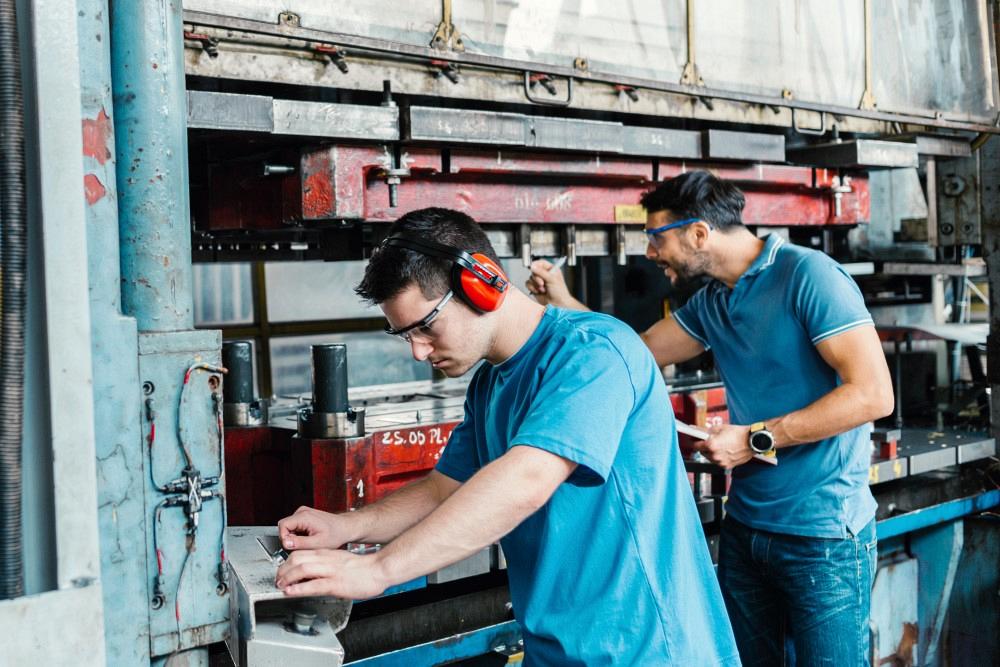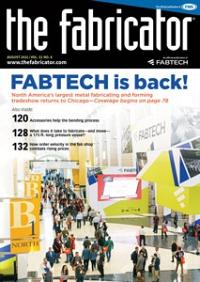General Manager
- FMA
- The Fabricator
- FABTECH
- Canadian Metalworking
Categories
- Additive Manufacturing
- Aluminum Welding
- Arc Welding
- Assembly and Joining
- Automation and Robotics
- Bending and Forming
- Consumables
- Cutting and Weld Prep
- Electric Vehicles
- En Español
- Finishing
- Hydroforming
- Laser Cutting
- Laser Welding
- Machining
- Manufacturing Software
- Materials Handling
- Metals/Materials
- Oxyfuel Cutting
- Plasma Cutting
- Power Tools
- Punching and Other Holemaking
- Roll Forming
- Safety
- Sawing
- Shearing
- Shop Management
- Testing and Measuring
- Tube and Pipe Fabrication
- Tube and Pipe Production
- Waterjet Cutting
Industry Directory
Webcasts
Podcasts
FAB 40
Advertise
Subscribe
Account Login
Search
Making the transition from fabricating to stamping
When and why to convert a part to a different metalworking process
- By Fred Simonson
- August 12, 2021
- Article
- Laser Cutting

When should a part make the transition from being fabricated to being stamped? It depends on what the end goal is. Stamping does require an investment in tooling, but the metal forming process can reduce labor costs and enhance product quality. Bluecinema/Getty Images
Typical fabricating job shops and OEMs make parts using traditional fabrication methods, such as turret punching, laser cutting, and press brake bending. But for the production of some flat sheet metal parts, the most efficient method is stamping using hard tooling.
Many companies already have both a fab department and a stamping department, and they understand the benefits of fabricating for lower-volume parts and stamping for higher-volume parts. They also know the part quantity they need to hit before they can justify moving a part to stamping, which involves a higher investment in tooling.
But how do shops and OEMs that haven’t yet ventured into stamping decide when to transition a specific part to this process? Before addressing that question, let’s explore some general information about stamping.
Advantages of Stamping
The primary advantage of stamping over fabrication is the reduction of labor. Running a progressive tool from a coil will yield 20 to 100 parts/min., and rates are much higher in high-speed applications. For hand-fed tools, such as single- and multiple-station stage tools or line transfer tools, production rates can be 80 to 180 parts/hour. These tools are suitable for jobs that don’t have the volume required to justify building a full progressive tool—perhaps an assembly that combines fabricated parts and hard-tooled stampings to eliminate costly press brake operations.
Another advantage to stamping is that part quality can be held to a higher, more consistent level. Progressive tools have pilots that position every hit within a tight parameter, providing high precision with each hit. Similarly, stage tools use location pins for consistent part positioning.
The Stamping Investment
The cost to bring stamping in-house can vary greatly depending on the size of your product and the level of stamping you are willing to take on. Used presses can cost $10,000 to $300,000, while new presses can range from $50,000 to more than $1 million. You also need to factor in the cost of feed lines if you intend to run progressive tools.
The cost for hard tooling can vary greatly as well. While high-end, class A tooling for the automotive industry is quite costly, the tooling required to transition out of fabrications typically is much more economical. The lower-cost tooling can achieve similar feed rates and part quality as the class A tool, but it doesn’t have all the special features and robustness. A small progressive tool can cost as little as $5,000, with a large progressive tool approaching $100,000. A typical tool that a tool and die shop might build for a small to medium-sized part would cost $12,000 to $35,000, depending on part size and complexity.
Building a tool used to require an enormous amount of skilled labor, but today’s advanced designs and machining processes have streamlined the tool build process, decreasing lead times and costs and making domestic tooling competitive with offshore pricing when all things are considered.
Case Studies
A successful OEM that was manufacturing its product entirely with traditional fabrication processes approached a tool and die company to inquire about converting a large segment of its product line from fabricating to stamping. This product in its current state went through laser cutting, eight hits on the press brake, and welding, including welding an additional piece on the part. Producing the part this way was very expensive. But a transition to stamping was challenging because the part came in multiple lengths.
The tool and die company proposed the use of two separate tools—a draw tool and a trim and extrude tool—in three operations, which would make all six variations of the part with changeover. This process replaced all other operations, including welding, resulting in enough projected cost savings to justify the purchase of a new press.
After successfully transitioning this part, the OEM has moved several more to stamping. Fabricating is still a large part of its operations, but stamping has proven its worth as a significant new competency for the company.
Another example is an OEM on the West Coast that fabricates its products using a laser cutting machine, press brakes, and a few presses for larger, high-volume parts. The process engineering group, charged with lowering labor costs, began investing in economical, no-frills progressive tooling and converting more of its parts from fabricating to stamping. The transition was so successful that the company has since added more presses.
Transitioning Your Shop
These examples are both OEMs, but the same transitions can happen in a traditional fabrication job shop. If you have products you are fabricating with lasers, turrets, and press brakes at volumes high enough that you could lose that work to a stamper, consider keeping that work in-house with a modest investment in press equipment.
Start with a smaller press to convert smaller parts to stampings. As your skill and comfort level increase and you start to see the benefits, grow that part of your business as a complement to your main fabricating business. With stamping, you can offer customers a production option when the volume of a successful product line increases, and they will appreciate the convenience of not having to move that product to another vendor.
What annual quantity is the trigger to convert from fabricated to stamped? This number can vary greatly depending on the part size and complexity, but the rule of thumb is about 5,000 to 10,000 parts per year. And the conversion doesn’t always have to be complete. On some parts, you might want to use laser cutting first and employ stamping as a secondary operation to gain top efficiency.
Lead time also will play a role in your decision to transition to stamping. The typical lead time to have a tool built is 8 to 18 weeks, depending on complexity. Once that tooling is ready, the press can run thousands of parts in days, while that same order would take weeks through traditional fabricating operations.
And don’t forget the other benefits that stamping can bring, like in-die tapping, in-die hardware insertion, and in-die fastening. These value-added processes may require a higher volume to justify, but they can pay off nicely in longer part life.
About the Author
Fred Simonson
1151 McKinley St.
Anoka, 55303
763-323-8877
subscribe now

The Fabricator is North America's leading magazine for the metal forming and fabricating industry. The magazine delivers the news, technical articles, and case histories that enable fabricators to do their jobs more efficiently. The Fabricator has served the industry since 1970.
start your free subscription- Stay connected from anywhere

Easily access valuable industry resources now with full access to the digital edition of The Fabricator.

Easily access valuable industry resources now with full access to the digital edition of The Welder.

Easily access valuable industry resources now with full access to the digital edition of The Tube and Pipe Journal.
- Podcasting
- Podcast:
- The Fabricator Podcast
- Published:
- 04/16/2024
- Running Time:
- 63:29
In this episode of The Fabricator Podcast, Caleb Chamberlain, co-founder and CEO of OSH Cut, discusses his company’s...
- Trending Articles
AI, machine learning, and the future of metal fabrication

Employee ownership: The best way to ensure engagement

Dynamic Metal blossoms with each passing year

Steel industry reacts to Nucor’s new weekly published HRC price

Metal fabrication management: A guide for new supervisors

- Industry Events
16th Annual Safety Conference
- April 30 - May 1, 2024
- Elgin,
Pipe and Tube Conference
- May 21 - 22, 2024
- Omaha, NE
World-Class Roll Forming Workshop
- June 5 - 6, 2024
- Louisville, KY
Advanced Laser Application Workshop
- June 25 - 27, 2024
- Novi, MI


























